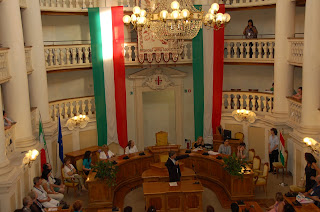Today was a full day with morning lectures about the cultural project that is the Loris Malaguzzi International Center, which is located in a former cheese warehouse. Carla Rinaldi spoke about the need for educators to have an international perspective, recognizing that the best pedagogy comes from the outside and that it is important to keep looking outward in a mode of “permanent research”. If you don’t research, you become stagnant and stuck in the status quo.
We also heard from the principal architect in charge of the building and renovation of the International Center as well as the graphic designer who led a team to create the logo for the center. Much of their presentations were unrelated to teaching, but their involvement highlighted how important it is for experts in these fields to understand the pedagogy of the schools.
The preschool and primary school attached to the International Center was designed by teams of pedagogistas, atelieristas, architects, and designers who took many things into consideration in its planning. We were not able to take pictures inside the school, but we have a few examples of the kinds of soft furniture designed for the schools. Here is what struck us about this unbelievable space:
• Huge open spaces, high ceilings, sky lights, large open windows, transparent walls and openings.
• The classrooms are situated around a large piazza that was large and open. In the piazza there was dress up, many places to pause/sit/explore, and resources for parents.
• There are spaces designed for small groups of children to do different activities.
• Every classroom had a mini-studio.
• There were 6 additional studios dedicated to light (huge screen), body/senses, movement & music, sound, painting (8’ X 4’ paper on the floor), and nature (stones, leaves, branches, projector and 3’ x 9’ light table).
• Each classroom was two levels, providing an opportunity for children to change their point of view. Second floor had sleeping cots and room for project work.
• The rear of the classroom was terraced with 12” risers. Creates smaller work spaces and endless possibilities for play.
• A paved courtyard with small stones.
• A dining area with a variety of table heights and chair/mat options.
• Bathrooms with 4 sinks of varying sizes and with different spigots to allow for water play.
• Tape measurers and lines representing the children’s heights in the bathroom with pictures of the children taped beside. In older classrooms a number recorded, too.
• Preschool classes had 24-26 children and two teachers. We have no idea how many studio teachers there were.
• Classroom walls were white with one accent wall of color. The rest of the center was light yellow, blue, green and orange.
• Very few blocks! Only 2 medium sized tubs and 1 tub of cardboard rolls for building. Perhaps to push children to look for alternatives?
• A light table embedded in a floor mat to enable children to crawl up to and/or lay down to explore or draw.
• At least three spaces for children’s belongings: mailboxes, cubby space, and portfolio collection boxes. Maybe lockers also—we didn’t open them, though.
• Did not see outdoor play space. Did have an amphitheater.
Kelley Organek and Susan Miranda, of Beverley Hills Church Preschool, will participate in the First International Summer School in Reggio Emilia, Italy from July 4 – 16, 2010. This experience will provide us a deeper understanding of the Reggio Emilia approach, and we plan to post our thoughts, reflections and pictures from our experience here. We hope that you will be in Reggio Emilia with us through this communication vehicle.
Tuesday, July 6, 2010
Happy 4th of July!





On Sunday, the 4th of July, we ventured to the Loris Malaguzzi International Centre to register and hear welcome remarks from Amelia Gambetti of Reggio Children. We boarded buses to the Tricolore Hall, where the Italian flag was born, to hear the mayor of Reggio Emilia welcome us. He was quite candid about the challenges of the town—a growing immigrant population, dwindling tax base, to name a few—but was proud to report that of children aged 0-3, 40% attend preschool in Reggio Emilia (compared to 10% nationwide). Our evening with Reggio Children concluded with a reception in the Piazza San Prospero—the Italians supplied the Americans with Independence Day accessories—and a walking tour of the city with Amelia’s husband, Sergio.
Subscribe to:
Comments (Atom)